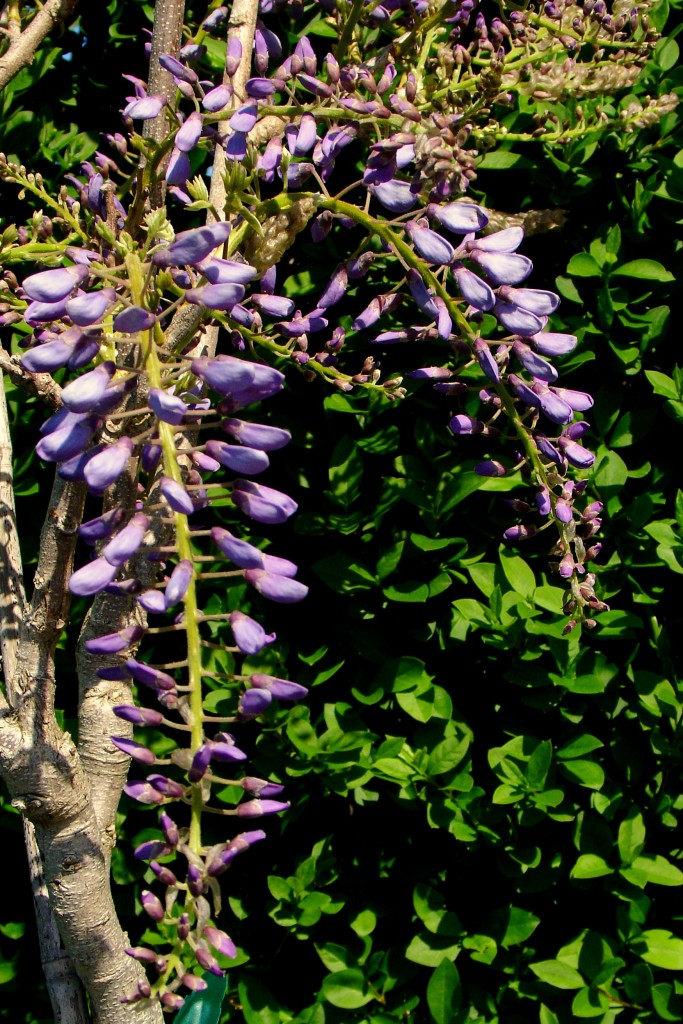Brad explains how to prune Hydrangea paniculata ‘Grandiflora’ Trees in this YouTube post. Check it out!
Woody Ornamentals
Oaks for Nantucket
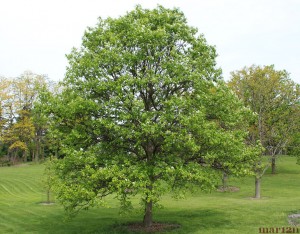
There are few trees that have such a long recorded history as the Oak. And it’s no wonder, considering that oaks are one of the longest living trees in the Northern Hemisphere. Astonishingly, the “Major Oak” growing in Sherwood forest in Nottinghamshire, England is touted to be between 800 and 1000 years old! There is a long standing tradition that Robin Hood actually used the tree as a hiding place while on the run from the Sheriff of Nottingham! Isn’t that cool? Yes it is!
Most oaks prefer slightly acidic, evenly moist, average soil. They are not generally fast growing, but eventually can become very large. The species following are all considered large trees when mature, and are often planted in parks and larger landscapes off island. Luckily, as with many trees, there are cultivars that will fit into smaller gardens. Upright cultivars like ‘Fastigiata’ and Regal Prince (r) are equally hardy and perform well on Nantucket
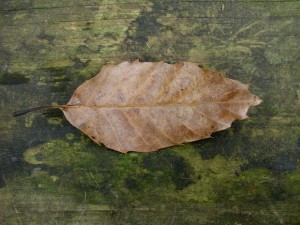
Sawtooth Oak, Quercus acutissima is a broadly pyramidal tree that might reach 40 to 60 feet tall on the mainland, likely somewhat shorter on Nantucket. It’s leaves don’t have a classic oak shape. They look much more like hornbeam or beech tree leaves to me. They open yellow in spring, mature to a glabrous green in summer and, in good years, will turn a clear yellow in November, before aging to tan. They are very easy to grow and resist pests and diseases. Like all oaks, they are slow to mature, and juvenile trees will tend to hold their leaves all winter. Sawtooth Oak can produce very heavy crops of acorns, and they are generally the earliest to ripen of the genus.
Swamp White Oak, Quercus bicolor, is a broad tree tree that will reach 50 to 60 feet tall on the mainland. The overall shape is a wide, round-topped crown, with a short trunk. The leaves of this species are much more recognizable; deep green, lustrous and lobed, with a grayish fuzz on the underside. Naturally occurring in moist areas with acidic soil, they are an ideal tree for a low area on your property in need of a majestic shade tree.
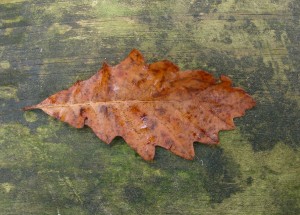
English Oak, Quercus robur, is also a broad tree with a height and spread of 40 to 60 feet on the mainland. The canopy is broad and rounded. The dark blue/green leaves of English Oak have a typical Oak-shape, with rounded lobes.
- Quercus robur ‘Fastigiata’ is an excellent upright cultivar that will grow very tall, but only 10-15 feet wide.
- We have also stocked Regal Prince (r), which is a hybrid between English and Swamp
White oak. This particular variety is touted to be very tight, almost oval in habit.
Pines
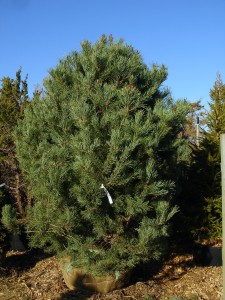
As deciduous trees and shrubs begin to drop their leaves, evergreens become more and more visible around the island. There are many species of evergreen trees that grow well on Nantucket. Pine trees are one of the most widespread.
Eastern White Pine, Pinus strobus, Scot’s Pine, Pinus sylvestris, Pitch Pine, Pinus rigida, and Jack Pine, Pinus banksiana can all be found growing in different areas of Nantucket. The majority of pine trees seen in our forested areas are Pitch Pine. This is a medium-sized tree that is native to eastern North America. Pitch Pines have shortish needles, in bundles of three, that are often slightly twisted. Although Pinus rigida is a sturdy tree with good salt tolerance, there are many better pines for landscape use. For this reason, it is not readily available in the trade.
We sell a variety of Pines at the nursery, however the following species are the most commonly planted today:
•Austrian Pine, Pinus nigra, is much more available and often used for screening and windbreaks. They are densely pyramidal in youth, and broad, flat-topped when mature. They can reach 30-50 feet tall, inland, but will tend to remain on the shorter side close to the shore. They are often the tallest trees in a given area, due to their salt and wind tolerance. They do well in average soil as long as it is well drained and prefer not to be on automatic irrigation, once established.
•Japanese Black Pine, Pinus thunbergii, is another common pine tree that we sell at the nursery. Like Austrian pine, they are tolerant of salt spray and wind and can survive coastal conditions. These trees have been widely planted on the island for years, and have become naturalized in some areas. Because this tree is not native to North America and produces viable seed, some consider it to be problematic, and it is being removed in several areas. Pinus thunbergii ‘Thunderhead’ is a highly ornamental cultivar that is worth a try. This tree is irregularly pyramidal, with long white buds that contrast well with its dark grey-green needles. More compact than the species, ‘Thunderhead’ reaches 10 to 15 feet tall in ten years with a dense habit.
•Bosnian Pine, Pinus heldreichii aka leucodermis, is of increasing popularity. It may be a good alternative for gardeners that prefer not to plant Japanese Black Pine. Trees in the nursery are arguably more ornamental than Japanese Black Pine, and denser in habit. They are touted to have comparable salt and wind tolerance of Pinus nigra and thunbergii and are suitable for planting in dry soils. Several landscapers on the island have found Bosnian pine to be less likely to suffer infestation by black turpentine beetles than others.
Fruiting Apples
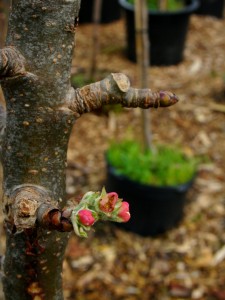
Have you ever noticed the difference between an apple you buy at Stop and Shop in June and a fresh-picked Massachusetts-grown apple in September? It’s remarkable how much better the flavor and texture is this time of year! If you are tempted to plant your own, why not take the opportunity to sample the range of fruit that might be available to plant.
When choosing apples to grow at home there are a number of important considerations:
- Space: An un-grafted tree grown from seed can reach 20′ tall and wide! With modern grafting techniques, however, pomologists can control the size of the tree. Dwarf and semi-dwarf trees are generally preferred for growing apples at home. Or, consider an espalier (A tree trained flat into a formal shape) these can be planted on a wall, or a post and wire system.
- Exposure: Fruit trees need lots of sun to produce! If the spot you have selected for you tree doesn’t have full sun, its unlikely that you will get a good crop of apples.
- Pruning: Apples require yearly pruning to produce the best crop. If you love pruning, apples are a lot of fun! It’s a good idea to follow a reference, Umass and Cornell have great extension services that have excellent websites. Take a peek at http://www.gardening.cornell.edu/fruit/homefruit/3treefruit.pdf and www.umass.edu/fruitadvisor/pdf/RINLA2011.pdf these are both great resources for apple culture.
- Pest & Disease issues: All fruit trees are susceptible to a myriad of pests and diseases. To limit the amount of spraying needed to produce quality fruit, always plant cultivars that are touted to be resistant to those problems.
- Pollination: Apples are not self-pollinating. This means that in order to set fruit, more than one variety must be planted that blossom at the same time. Do your research! Make sure the varieties you chose to plant overlap their bloom period, otherwise its possible neither tree will bear fruit.
- Harvest Time: Depending on the variety, apples will ripen and can be harvested from late August all the way until frost. Consider planting varieties that will provide fruit in succession.
- Use: Choose varieties that suit your needs. Do you like to make apple sauce and butters? ‘McIntosh’ and varieties like it are ideal for that purpose. ‘Braeburn’ makes a great pie. ‘Jonamac’ is delicious eaten out of hand. Cider is another great way to enjoy apples, try combining varieties to create a ‘House Blend’.
We stock many apples at the nursery, and are happy to source individual varieties you might be interested in. Whether a mature tree is needed for your project or a young containerized plant is ideal, we can provide a plant that will fit the need.
Thornless Honeylocust
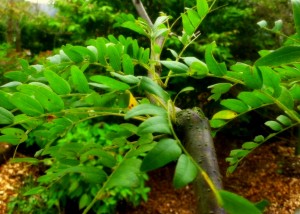
Trees are one of the most impactful elements of any landscape. There are so many trees to chose from, it can be tough to select the right one for each application. Thornless Honeylocust is a great tree to plant in the lawn. It’s open branching and delicate leaves cast only dappled shade, so grass can be grown right up to the trunk, if desired.
In general, Gleditsia have a spreading irregular habit with ferny foliage. The leaves are green in summer and turn yellow in fall. Most cultivars have a short trunk and a wide spread. Some varieties will produce pendulous dark brown, twisting seed pods, that hang from the branches until late in the season, which can be a drawback. This tree is touted to be extremely tough and incredibly salt tolerant. However, during Irene, Gleditsia on the island suffered the same foliar damage as other deciduous trees.
There are several cultivars readily available in the trade, each with slightly different habits. Consider the following cultivars for your landscape:
Halka TM : Wide, symmetrical canopy. 40’t x 40’w in ideal conditions, closer to 30′ on the island. This variety may produce 8″ long pea-like seed pods that ripen to black and hang on the branches until late in the season.
Skyline R : Pyramidal form, with ascending branches. This variety maintains a central leader, making it appropriate for limbing up to create a higher canopy than most. 40’t x 35’w in ideal conditions, shorter on the island. Essentially podless variety.
Shademaster R: Excellent growth habit, upright ascending branching producing an irregular vase-shaped or rectangular form. Generally doesn’t produce seed pods. 45’t x 35′ w in ideal conditions, shorter on the island.
Salt and Wind Damage
After much hype and preparedness, Tropical Storm Irene blew across the island on Sunday with, thankfully, far less damage than forecasted. Now that any major issues resulting from the storm have been taken care of, and broken tree limbs have been cleared away, the flower garden might seem a little worse for wear! High wind, combined with salt spray and sand have left many plants with broken stems, and tattered leaves. Unfortunately, the battering and desiccating effect of the wind will continue to become more and more noticeable over the next few days.
Although the damage seems severe, especially in unprotected areas, remember that plants are resilient. It may look like someone has taken a blow torch to many of your prised plants today, but in time, nearly every plant will make a total recovery! So what can we do to help speed the process along and improve the overall look of the garden?
- Give your plants a gentle shower with the hose to rinse off any salt that is still on the leaves.
- It’s still hot out there! Be ready to add supplemental water in the areas of the garden that tend to get dry. Additional stress from drought will hamper growth.
- Where time and patience allow, remove brown leaves from plants in the most visible areas of the garden.
- Cut back, or re-stake tall perennials that have been blown over.
- Visit the Nursery! A few well-placed additions to the garden can really help brighten things up, as we transition into the shoulder season.
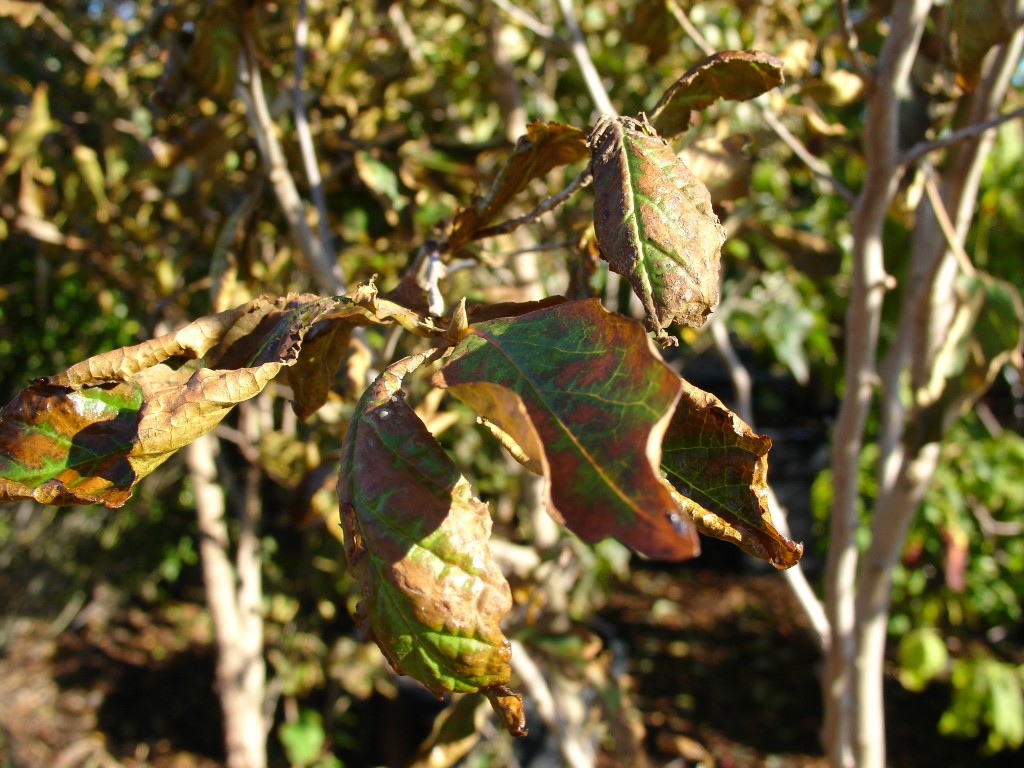
Myth: Drought Tolerant Plants don’t need water
MYTH: Drought tolerant plants don’t need supplemental water
TRUTH: All plants need water!
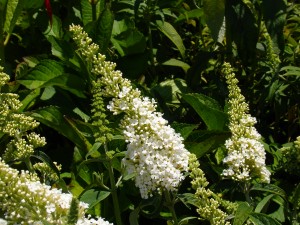
Drought tolerant plants are those that, once established, will survive receiving the typical (or slightly less than typical) amount of rainfall in our area without the need for supplemental irrigation.
But to be clear, surviving isn’t necessarily garden tour ready! Prolonged periods without rain force the plant to conserve water in its most important tissues. With herbaceous plants, that’s the roots. For woody plants, this also includes the framework above the ground. Plants need a lot of water to produce new growth and keep their leaves hydrated. So, during times of drought many plants will stop growing all together and begin to shed leaves. Some plants will go completely dormant, and appear like they normally do in winter, with no sign of life at all above the ground.
In order to keep your plants looking their best, it’s a good idea to give them a deep soaking if it seems dryer than normal.
Keep in mind, plants that are considered drought tolerant generally have very extensive root systems, or a long taproot. When plants fresh from the nursery are put into the ground, they don’t have those roots yet to help them pull in moisture. We recommend keeping the area around new plants consistently moist (not soaking) for at least the first two weeks after planting. This give the plant time to send out new roots into the surrounding soil. After the first two weeks, monitor the soil in the bed. If there isn’t enough rain to keep the soil damp down a few inches, water weekly.
Wisteria: Summer Pruning
If you have ever seen a well trained Wisteria in full bloom in June, you may be tempted to add one to your garden. Keep in mind, Wisteria isn’t one of those plants you can put in the ground and forget about. Pruning in winter is very important, but there is pruning needed in summer, as well.
Before you get started, keep in mind your objectives:
- To cover the support structure with well placed branches
- To promote heavy flowering close to the main framework of branches.
Specific Summer Pruning Objectives:
- To keep the vine in bounds
- To increase sun penetration
- To tie in new shoots to cover the support
SAFETY FIRST:
Working large vines that reach several stories overhead can be very dangerous. Follow these rules when pruning on a ladder:
- Asses the support structure. Even pressure-treated wood and cedar will rot over time. Make sure the structure can support the vine and any weight you might put on it while pruning.
- Nantucket is windy! Avoid working on a ladder on windy days.
- Work with a partner. Someone on the ground to clean up and steady the ladder is very helpful.
- Never stand on the top two rungs of a ladder
- Work from below a pergola. Never climb up on top to prune. It is very easy to trip in the tangled vines or damage the laths.
With the objectives in mind, and safety as the top priority, begin to prune.
- Cut back long tendrils to 6 inches. These vegetative shots will not flower and will shade the inner portions of the vine next to the support. In order to ensure good flower bud set, sun must penetrate into the Wisteria during the growing season.
- Remove long side shoots at the base of the vine. This lateral growth will run along the ground and root, causing the wisteria to spread. *If the shoots arise from below the swelling where the Wisteria was grafted, it is even more important to remove them. It is nearly certain that these shoots will not possess the characteristics of the scion (the desirable grafted portion of the plant) and may be even more aggressive and difficult to control.
- Tie strong shoots onto empty portions of the support. It is best to work systematically across the wisteria, pruning and tieing as you go. It helps to keep a center-pull ball of just twine in your pocket; this way, there is no need to climb up and down the ladder each time a vine needs to be tied.
Need a better visual? Check out our YOUTUBE video : www.youtube.com/watch?v=9BxUKPA4vx0&feature=youtu.be
Flowering Crabapples
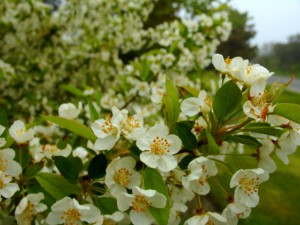
As ornamental Cherry trees come to the end of their bloom cycle on the island, crabapples have picked up the baton. Small to medium-sized trees, crabapples are a great addition to almost any landscape. They seem right at home anchoring a foundation planting, or in a grove at the edge of a wooded area. A well-pruned standard can make an amazing focal point in a small garden this time of year.
There are a few things to consider when choosing a crabapple for your garden.
- Form: Standard, Multi-stem or Weeping
- Fruit Color: Yellow or Red
- Leaf Color: Lustrous Green to Deep Burgundy
- Flower Color: White to blush to Crimson
- Disease Resistance: Fire blight and other foliar diseases can be an issue
A few Common cultivars and their attributes:
- ‘Adams’: Rounded form, reddish foliage, carmine to pink flowers, red fruit, 20-25′
- Centurion (R): Upright branched form, dark green-red tinted leaves, rose-red flowers, red fruit, 20-25′ T
- ‘Donald Wyman’: Large spreading form, lustrous green foliage, pink-white flowers, red fruit, 20′ T x 25′ W
- ‘ Harvest Gold (R): Vigorous, vase-shaped form, white flowers (a week later than other varieties), gold fruit, 30′ T x 20′ W. Great disease resistance.
- ‘Louisa’: Broad-weeping form, glossy dark green foliage, red buds opening to pink, red fruit, 15’T x 15’W
- ‘Mary Potter’: Mounded, spreading form, lustrous green foliage, dark pink buds opening to white, red fruit, 15′ T x 20′ W
- M. sargentii: Wide-spreading form, dark green foliage, red buds opening to white flowers, bright red fruit, 8′ T x 12′ W
- M. x zumi ‘Calocarpa’: Dense, rounded form, dark green foliage, pink-white flowers, red fruit, 25’T x 25’W
Ornamental Pear Trees
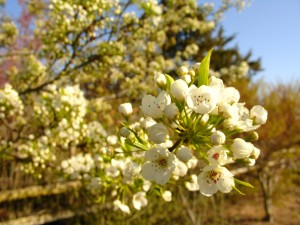
Ornamental pear trees are in full bloom across Nantucket this week. These adaptable trees have been widely planted throughout the country. They are disease resistant, with lustrous green leaves, and often have good fall color. This time of year the entire canopy is filled with sprays of delicate white flowers.
There are many popular selections, each suitable for different situations. Some common ones are listed below, with noteworthy characteristics.
- New Bradford (R) An improvement on the ubiquitous ‘Bradford’ Considered to be hardier with superior foliage. Reaches 35′ or more in height, conical in youth, becoming more broad with age.
- Aristocrat (R) Distinguishable from other ornamental pears by its wavy -edged leaves. This selection tends to maintain a strong central leader and grows to around 35′ tall and 16′ wide.
- Chanticleer (R) AKA ‘Select’, ‘Cleveland Select’, and ‘Stone Hill’ An upright pyramidal selection, still reaching 35′ tall, but slightly narrower than Aristocrat (R)
- ‘Trinity’ AKA ‘Sylvania’ Much more rounded selection reaching 30′ x 30′ in maturity.
- P. fauriei Korean Sun TM AKA ‘Westwood’ Compact rounded habit, only reaching 12′ – 15′ in height. Red/Purple fall color.

